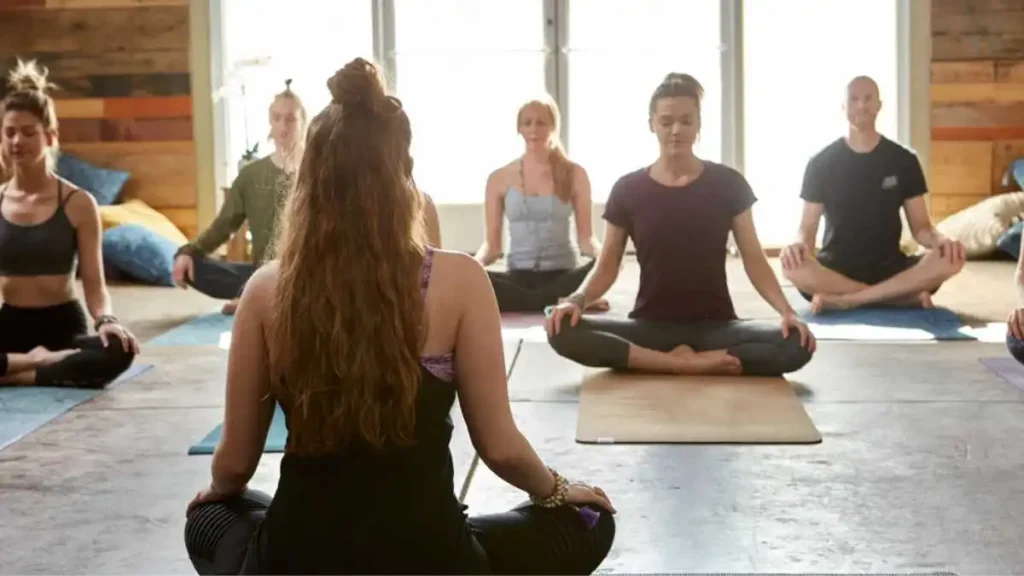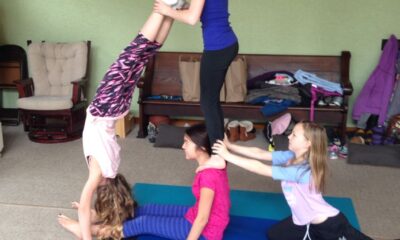YOGA
From Student to Teacher: Navigating Yoga Instructor India’s Certification Process

Yoga has developed from a centuries-old practice to a worldwide known lifestyle option with emphasis on physical fitness, mental well-being, and spiritual development. With the increasing popularity of yoga worldwide comes the need for professionally qualified trainers to teach yoga aspirants how to progress. As the cradle of yoga, India is now the top destination for those intending to take up yoga instruction with certification to impart the values of this venerable discipline.
The path from yoga student to registered yoga teacher is a life-changing one that demands discipline, self-reflection, and devotion to the study of not only the physical but also the philosophical components of yoga. This path is about more than merely mastering postures and sequences; it is an in-depth discovery of the practitioner and an immersion in the rich heritage of yoga. This blog will walk you through the different steps of how to become a certified yoga teacher in India, right from the learning process to becoming certified and more.
Table of Contents
1. The Foundation: Becoming a Yoga Student
Before starting the journey to become a certified yoga teacher, you have to have a wide base in yoga. Yoga involves more than just physical attitudes; Rather, it is a complete system for breathing (pranayama), meditation, physical attitudes (asanas), and moral principles (Yamas and Niyam). As a student, you will be responsible for studying everything yoga offers.
A true practice of yoga entails dedication, routine, and forbearance. For a newcomer, it’s best to first learn under a good yoga instructor. In India, numerous ashrams, schools of yoga, and wellness institutes have classes open to students from beginner to advanced levels. Developing an individual practice and enhancing knowledge about the basic principles is extremely important before looking into taking the step towards becoming a teacher trainer.
Prior to beginning your path as a successful yoga instructor in your life, ensure you have laid strong ground for yourself.
If you prepare ahead of time and gain this knowledge, you’d probably have an advantage that would easily carry over into your later learning experiences. Therefore, attend different classes, explore the methodology of breathing exercises, and expand your knowledge base to position yourself to become a yoga instructor.
2. Choosing the Right Yoga Teacher Training Course (YTTC)
Make sure the YTT program you choose is recognized by some reputable organizations, such as yoga coalitions. Moreover, ensure the programs are thoroughly supported by professional teachers and comprehensive classes.
The most popular are the 200, 300, and 500 hour certifications, with the most popular first step being a 200 hour certification. Once you locate a YTTC program you feel comfortable with, and the course is properly scheduled, it is key to choose the right yoga school for your YTTC program. The decision of the school will determine the quality of the course you receive.

Many yoga schools in India are accredited through the Yoga Alliance, an independent international organization that established standards for schools that provide yoga teacher training. Better yet, certified programs through the Yoga Alliance ensure that the scope and the course followed appropriately reflect the accepted standards.
Some things to look out for when picking a YTTC are:
- Yoga Style: There are many types of yoga instruction, including Hatha yoga, Vinyasa yoga, Ashtanga yoga, and Kundalini yoga. It is important to pick a training program that fits your practice and teaching interests.
- Location: India has many popular yoga centers, such as Rishikesh, Goa, and Mysore, that offer yoga training programs. Depending on the location, this can affect your experience since some places can be quite traditional or tranquil, while at other places it may be a more commercialized experience.
- Instructor Qualifications: Research the credentials and experiences of the instructors teaching the training program. The instructors must be trained not just in yoga (advanced level studies) but also be capable facilitators to teach and instruct yoga.
- Testimonials and Reviews: Explore reviews of past students for some feedback about the training and experience.Curriculum: Make sure the training program covers anatomy and physiology, yoga philosophy, yoga methodology, and teaching practice.
3. Yoga Teacher Training Curriculum
The curriculum in a YTTC will vary depending on the style of yoga and school, but most courses have some common elements. Below, you will find a description of the content typically delivered during a 200-hour yoga teacher training:
a. Yoga Asanas (Postures)
(Postures)You will spend a lot of your training honing and refining your physical practice, which includes learning lots of postures (asanas), their alignment, their benefits, and the contraindications for each posture. You will also spend a lot of time learning how to teach the physical postures, including cueing, modifications, and adjustments for a variety of body types.
b. Pranayama (Breathwork)
(Breathwork) Pranayama, or breathing control, is an important component of yoga. You will be aimed at controlling and expanding your breath, which is important to maintain energy and calm your mind when practicing yoga. Teachers will support you in developing your pranayama practice and provide you with the skills to teach your students.
Yoga philosophy includes ancient texts such as Yoga Sutra, Bhagavad Gita, and Hatha Yoga Pradepika from Patanjali. For example, the exercise of Yama and Niyam (moral principle), concentration practices, and self-interviews are important for distributing your personal development and yoga classes.
c. Yoga Philosophy
Yoga philosophy comprises teachings derived from ancient texts such as the Yoga Sutras of Patanjali, Bhagavad Gita, and Hatha Yoga Pradipika. You should also be aware of the ethical aspects of yoga (yamas and niyamas), concentration practices, and the theory of self-realization to cultivate your own practice and facilitate student learning.
d. Anatomy and Physiology
Having anatomical knowledge about the human body’s structure is necessary for you to teach successfully and safely. You learn the anatomy of the muscles, bones, and joints and understand how they relate to the content of different asanas. This will help you learn to avoid injuries and direct your students to their most effective and safe alignment in their practice.
e. Teaching Methodology
As an emerging teacher, you will learn the skills of teaching yoga. This includes class sequencing, lesson planning, and communication. You will receive practice teaching in a supported environment with valuable feedback from experienced teachers and fellow students.
f. Practical Teaching Experience
One of the most valuable aspects of the YTTC course is that you will receive real-time teaching experience. You will be supported in teaching a set of classes under the guidance of an experienced instructor, which will help you build your confidence, learn communication skills, and apply what you have gained in knowledge.
4. The Certification Process
After your training program is complete, ensure that you obtain a certification. And for that, you would have to go through an evaluation that would confirm you have gained all the important skills and learnings to become a yoga instructor. The school would grant the certification only after you have completed teaching assessments and written tests.
Once you have that certification in hand, you can finally teach yoga at a yoga studio, yoga school, fitness center, and various other types of settings. Once you have completed the Yoga Teacher Training Course, you will be granted certification. If you are a 200-hour program student, you will receive the 200-Hour Yoga Teacher Certification, which is recognized by Yoga Alliance only if your school is an approved school.
In India, the Yoga Alliance certification is sometimes seen as a ‘badge of honour’, especially if teaching abroad is the goal. There is certification as well for each country/region through local yoga organizations and/or universities within India proper. Once you receive your certification, you can begin teaching yoga. Experience can be had by teaching at yoga studios, private sessions, or workshops and retreats. With time, you will hone your teaching skills, develop your client base, and possibly move up to more advanced levels of certification, like a 300-hour or 500-hour program, if that is your aspiration.
5. Continuing Education: Beyond the Certification
While completing a yoga teacher training course is a great accomplishment, being a skillful yoga teacher requires lifelong learning and self-reflection. Most seasoned teachers continue to expand their learning and knowledge in focused areas of yoga, such as restorative yoga, yoga therapy, or meditation. To maintain your certification with Yoga Alliance, you must complete continuing education credits (CECs) as part of your cycle by attending workshops, seminars, or related courses. CEC implementation helps to keep yoga teachers up to date with the latest practices, safety measures, and trends in the field.
Participating in personal practice, teaching, and workshop attendance will assist you in developing as a teacher, developing your voice, and becoming more deeply knowledgeable about yoga’s deep teachings.
Now if you want to become more credible as a yoga instructor so that you can excel in your profession and develop leaps and bounds, then you should register for RYT and CPR certification. RYT (Registered Yoga Teacher) certification is offered by international bodies such as Yoga Alliance and it provides you with a certified yoga teacher. The process would involve forwarding your training papers and certificates.
6. Challenges and Rewards of the Journey
The process of becoming a teacher from a yoga student is not easy. To become a good yoga teacher, one needs to be patient, persistent, and open to learning and development. Some of the common issues that new teachers may encounter are:
- Imposter syndrome: Most new teachers will feel uncertain about their capabilities, particularly when they are new. Overcoming this calls for regular self-reflection and development.
- Finding students: It can be difficult to build a clientele and find students, particularly if you are teaching independently.
- Class management: Class management, meeting individual needs, and keeping energy levels up throughout the session takes time to practice.
- Balancing your practice and teaching: The more you teach, it is to forget about your own practice. Keeping your practice up is important to being a good teacher.
Regardless of the difficulties, the benefits of a yoga teaching profession are priceless. Seeing students learn and grow, assisting them in overcoming challenges, and being there to be a part of their transformational process is profoundly rewarding. As a yoga teacher, you get to share the ancient wisdom of yoga, not only improving others’ lives but also ongoing personal and spiritual development.
Conclusion
Becoming a teacher of yoga from being a student of yoga is an opportunity for deep personal growth and development. It is a way to physically take care of yourself but the spiritual system is a way of living an intentional, peaceful life. The certification process in India allows a future yoga teacher to develop the knowledge and skills required to teach with competence and safety. By choosing a complete yoga teacher training program, by committing to continuing education, and living the practices of yoga, you can transition into becoming a yoga teacher and sharing this ancient wisdom with others. Your certification is simply the first step in what can become a lifelong journey of learning, teaching, and exploring.
1. Can I teach yoga without certification?
Even though most yoga studios and yoga schools across the world expect a yoga teacher to have a certification to teach yoga, you can still technically be a yoga teacher without a certification. If you have the skills and knowledge that are necessary, you may choose to teach yoga online or become a teacher at small yoga studios, You could also work at gyms, hospitals, or fitness centers.
2. What is the difference between RYT 200, RYT 300, and RYT 500?
RYT stands for Registered Yoga Teacher; the distinctions between RYT 200, RYT 300, and RYT 500 are simply levels of certifications being offered per a level of standard established by Yoga Alliance. So, if you take a 200-hour yoga teacher training course, you would become an RYT 200, then you would be recognized as an RYT 300 after you complete an additional 300 hours of training to receive your advanced level certification, then again RYT 500 would differentiate someone as completing a total of 500 hours of training to receive a top level certification as a yoga teacher. So, RYT 200 is the beginning or foundational level of certification followed by advanced being RYT 300 and RYT 500 is the highest level of certification.
3. Is online YTT as effective as in-person training?
Even though online yoga teacher training is increasingly being adopted each and every day, the majority of yoga students and yoga schools worldwide still prefer traditional face-to-face yoga training. Online Yoga Teacher Training (YTT) is acceptable to most yoga schools according to certain variables (quality of program, recognized by Yoga Alliance, etc…).
4. How long does it take to be a yoga instructor?
To be a yoga teacher, you need dedication, patience, and a lot of hard work. You can be a yoga teacher after finishing your yoga TTC of 200 hours or 300 hours, and it takes about 3 – 5 months to complete a yoga course. After you have undergone your training, you are able to teach in a yoga studio, yoga school, fitness center, etc.
5. How much do yoga instructors make?
The amount of money a yoga teacher makes depends a lot on their location. Also, the experience of the individual yoga instructor. For example, as a beginner, you can earn a comfortable amount anywhere in the range of $20-$30 per session. As an expert, it is possible to earn over $100+ per session of yoga. On the contrary, if you are a full-time yoga teacher, the average yearly income can be anywhere from $30,000 to $70,000. Again, it all depends on so many variables-location, experience, clients, and of course, the services.
-

 GENERAL2 months ago
GENERAL2 months agoUncovering the World of кинокрадко: The Dark Side of Film Piracy
-

 GENERAL1 month ago
GENERAL1 month agoUnveiling the Art of преводсч: How Translators Bridge Language Barriers
-

 YOGA1 year ago
YOGA1 year ago4 Person Yoga Poses for Beginners
-

 GENERAL2 months ago
GENERAL2 months agoThe Journey of iamnobody89757: From Anonymous User to Internet Sensation


























